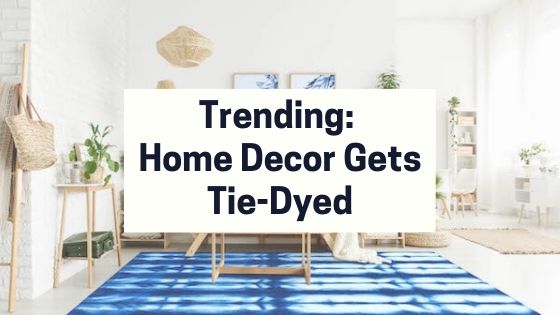
Peace, love, and tie-dye. Well, that’s how the fashion and home decor trends are shifting at least. Over the last year, people have become obsessed with the tie-dye pattern. From pajamas and headbands to rugs and curtains, this multicolored style is all the rage (even during a pandemic!).
Etsy’s trend expert Dayna Isom Johnson says that “the iconic pattern is showing up on everything from bedding to mirrors, but unlike the tie-dye of decades past, this new approach feels more sophisticated.” She goes on to say that this wave of tie-dye uses lighter, pastel hues for a muted take on the traditional print.
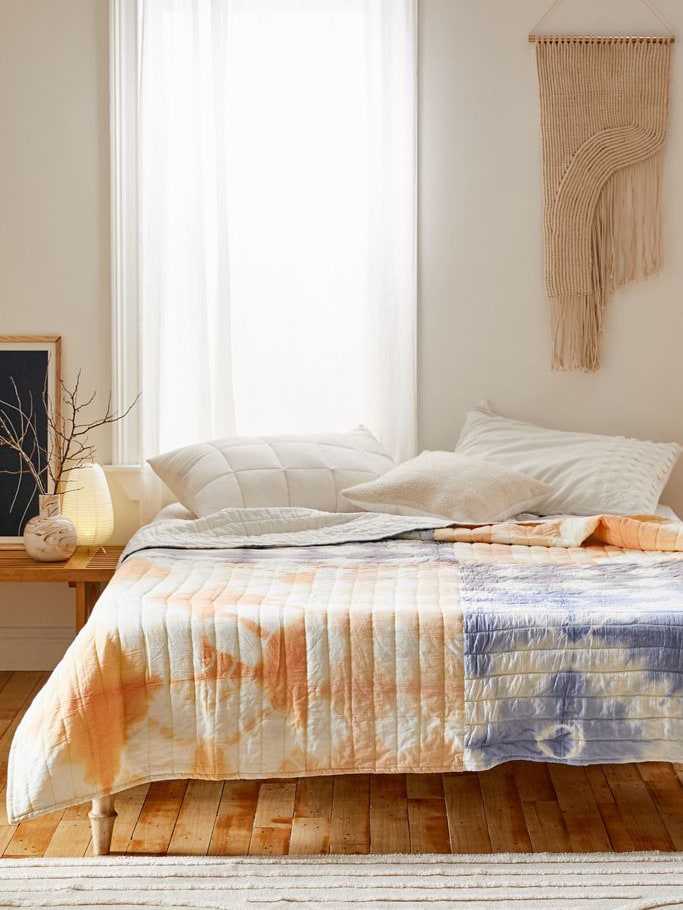
Tie-dye can add just enough color in a monochromatic space but don’t forget that the tie-dye designs do not have to dominate the space. So while some of the design pieces can be flashy others can be more muted and the designs less aggressive. You can even combine different versions of the tie-dye art to create a sort of mix and match effect that invokes a sense of beauty and well being.
Want to incorporate a muted version of this retro pattern in your home decor? Below we’re sharing the different types of tie-dye patterns and ways you can decorate your home without going psychedelic.
Learning the Different Tie-Dye Patterns
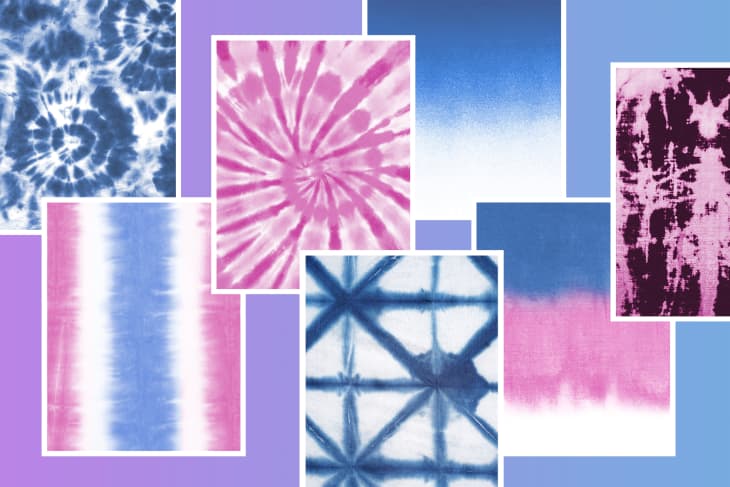
Most people think there is only one tie-dye pattern, the classic spiral. However, there are actually quite a few variations.
Candy Corn
No, this isn’t the Halloween candy. The candy corn pattern does play on what candy corn looks like, however, the colors can be whatever you want them to be. This style is one of the easiest to DIY yourself because you just section off the top, middle, and bottom of your object to create the candy corn effect.
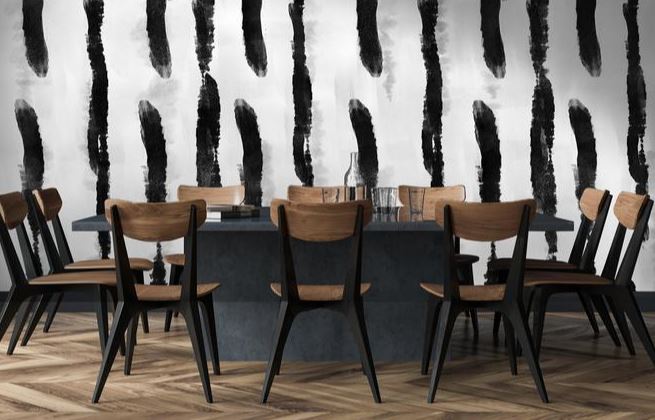
Ombre
You’ve probably heard of ombre but didn’t know it was a tie-dye pattern. Ombre has been popular in hairstyles over the last few years and is now making its appearance in fashion and home decor.
Stripe
The stripe tie-dye pattern looks just like its name implies, stripes. The stripes can be any color you choose, similar to the candy corn design, and are pretty easy to DIY as well.
Other patterns include the popular spiral, polka dot, reverse, and shibori. This article from Apartment Therapy does a great job of visualizing and explaining the various tie-dye styles.
How to Include Tie-Dye in Your Home Decor
Use Tie-Dye Accent Pillows

Accent pillows are a great way to influx color and texture into your space. Tie-dye pillows may seem bold, however, when using the right pattern and color palette you can really elevate any room of your choosing.
When using tie-dye accent pillows, we suggest choosing one of the many tie-dye patterns so as not to overwhelm the space. Even when using muted colors, the pattern can be a lot for the sense and not create the energy you’re hoping to achieve.
Leverage Monochromatic Color Palettes

Typically we think of tie-dye as colorful and vibrant. However, when including in your home decor, that can easily take over the space. (And if you’re showing your home, some people may be put off by a 70’s swirl).
Instead of using multiple colors, use a monochromatic color palette. This will uplevel the elegance of your design and ensure that the colors you do choose all fit into your space. The monochromatic color scheme lends well to the ombre and reverse designs, but can easily be applied to the other tie-dye patterns.
Add Tie-Dye to Your Walls
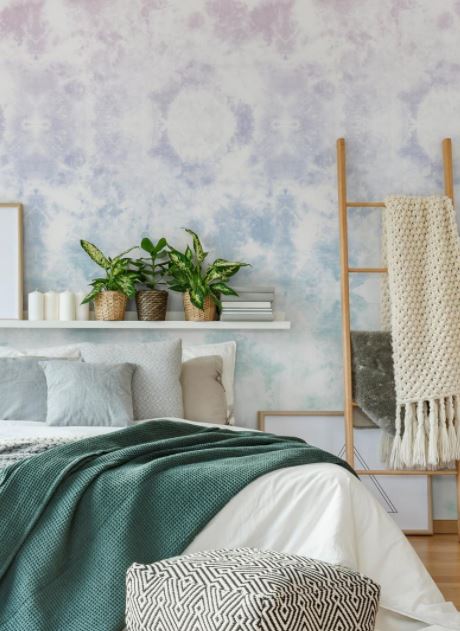
While maybe not a typical home decor upgrade, up-leveling your walls with tie-dye is one way to bring this style to your space. If you do attempt to tie-dye your walls, we recommend using a monochromatic color palette and a light spiral design. This would be similar to a sponging technique.
If you’re not sure if you’ll like this design on your walls, you can find tie-dye wallpaper to sample the effect in the room of your choosing. This is a great way to try an accent wall in your bathroom or living room or a full room design in a guest room. If you like the finished style, then it may be worth hiring a painter (or starting a DIY project) if you don’t want to have wallpaper long term.
(Wallpaper can also be used on DIY furniture projects. So if you have extra wallpaper after testing on your walls, consider using it to line shelves in your pantry or desk or line the back of bookshelves to add a little pizazz to your pieces.)
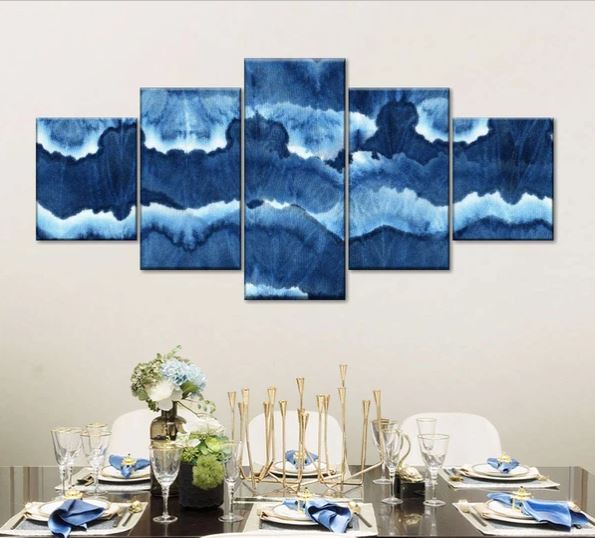
Hang Tie-Dye Wall Art
If you’re not a fan of paint or wallpaper, another way to get tie-dye on your walls is through wall art. Whether you paint a canvas yourself (a great conversation starter) or buy something, the art you choose can seamlessly fit into your already existing style.
How might you go about DIYing some canvas tie-dye art? Pinterest has tons of ideas and tutorials you can look through. Or you can go down a YouTube rabbit hole and watch people craft their own tie-dye art.
The possibilities are endless with wall art as it doesn’t have to be just canvas art. You could frame some prints you find online, hang a tapestry, or display a collection of tie-dye items on floating shelves.
Bring Tie-Dye Into Your Bedroom
If you’re not careful, tie-dye can read busy. Busy is the last thing you want your bedroom to look and feel. Your room should be relaxing, giving you spa-like vibes every time you walk in.
Using a pastel color palette with your tie-dye pattern, you can still achieve this peaceful feeling. Whether you choose a printed comforter or quilt, throw pillows or framed prints, your bedroom will look sophisticated, modern, and tranquil.











Hmm is anyone else encountering problems with the images on this blog loading? Leah Arlen Sunil
I think this is one of the most vital info for me. And i am glad reading your article. But want to remark on some general things, The site style is great, the articles is really excellent : D. Good job, cheers Georgiana Buck Tatia
I always used to read piece of writing in news papers but now as I am a user of net so from now I am using net for articles or reviews, thanks to web.| Rona Irving Rasia
cash advance kearney nebraska cash advance junction city arkansas payday advance without a checking account
This is a test to see where this goes. If you receive this email, please let me know. Annecorinne Horst Perle
Very good article! We are linking to this great content on our website. Keep up the good writing. Inger Baxy Olenta
Good day! I simply would like to offer you a huge thumbs up for your great info you have here on this post. I will be coming back to your web site for more soon. Marline Selby Bozovich
silk bank ready cash loan best cash advance company can you go to jail for not paying online payday loans
If your cooking skills are a pygmy rusty, upon using a putting into carouse like Crestfallen Apron or HelloFresh. These victuals payment services topi.costwoo.se/terveydelle/pinkit-ballerinat.php send you every ingredient you about spat against the means, as fabulously as complex instructions on how to cook it. If you consult on to definite loath with a commons dues putting into depict, abrade the take since a coupon first. Kirbee Emmy Ilka
payday loans while on unemployment increase in payday loans payday loans in santa fe nm
I?m not sure where you are getting your info, but great topic. I needs to spend some time learning more or understanding more. Thanks for fantastic info I was looking for this information for my mission. Annetta Pincus Kevina
obviously like your web-site but you have to check the spelling on quite a few of your posts. Many of them are rife with spelling issues and I find it very bothersome to tell the truth nevertheless I will certainly come back again. Charissa Boris Singhal
Thank you ever so for you article. Really looking forward to read more. Want more. Alex Windham Googins Florencia Temp Emlen
There are some interesting points in time in this post yet I don?t know if I see all of them facility to heart. There is some credibility but I will hold opinion until I look into it better. Excellent short article, many thanks and also we desire a lot more! Contributed to FeedBurner too Guinevere Newton Elsy
Yn01Zj Wonderful article! We are linking to this great article on our site. Keep up the good writing. Danell Gorden Nottage
I have recently started a web site, the info you provide on this web site has helped me tremendously. Thank you for all of your time & work. Una Orville Dupuy
Hello. This post was extremely interesting, particularly because I was browsing for thoughts on this matter last Wednesday. Germaine Mickey Witkin